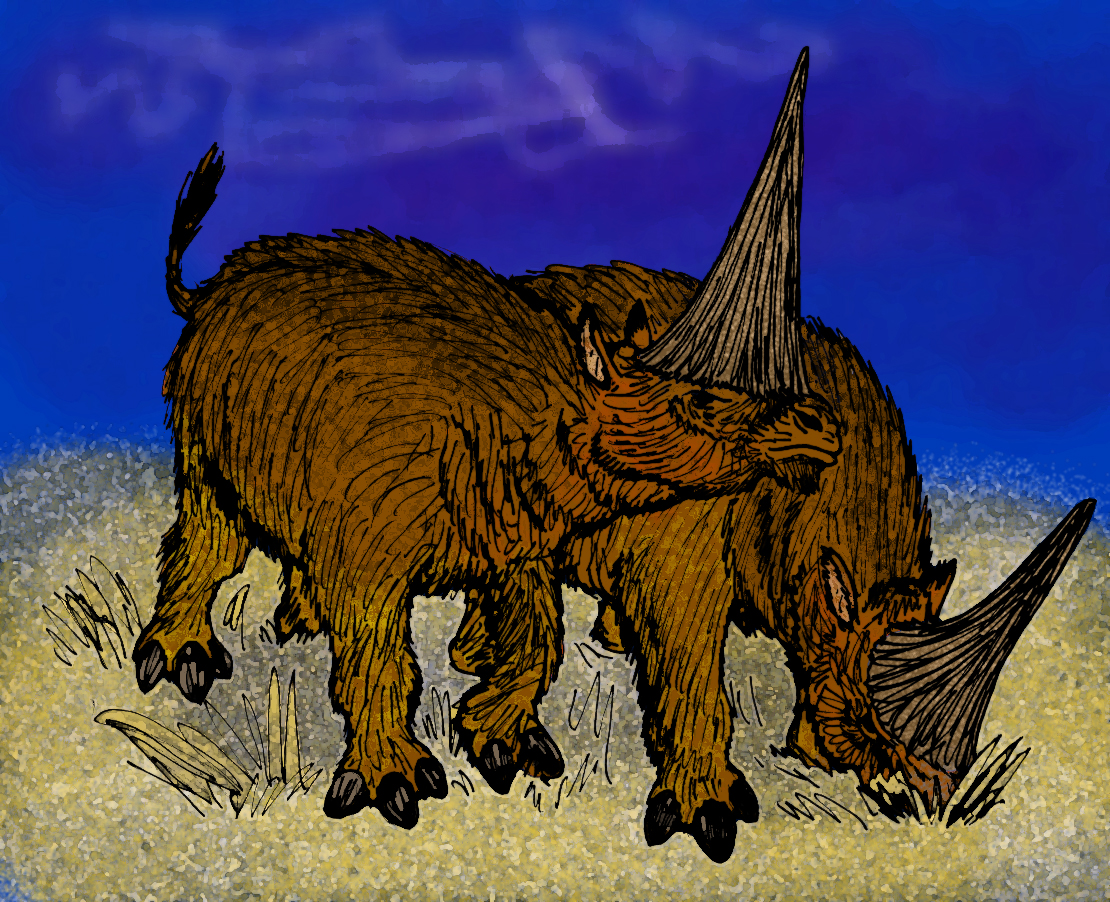- Elasmotherium
fossil_range = LatePliocene to LatePleistocene
status = fossil
regnum =Animal ia
phylum = Chordata
classis =Mammal ia
ordo =Perissodactyla
familia =Rhinocerotidae
genus = "Elasmotherium"
genus_authority = J. Fischer, 1808
subdivision_ranks = Species
subdivision =
* "E. sibiricum" (type species )
* "E. inexpectatum"
* "E. pei"
* "E. caucasicum""Elasmotherium" ("Thin Plate Beast") was a
genus of giantrhinoceros which stood, on average, convert|2|m|ft|abbr=off high and convert|6|m|ft|abbr=off long, with a single two-meter-long horn in the forehead. The animal may have weighed up to convert|5|t|ST|abbr=off|lk=on. Its legs were longer than those of other rhinos and were designed for galloping, giving it a horse-like gait. It was probably a fast runner, in spite of its size. Its teeth were similar to those of horses, and it probably grazed low herbs.The genus appeared during the Late
Pliocene inCentral Asia , being derived from thegenus "Sinotherium ". "E. inexpectatum" and "E. peii" inhabited EasternChina during theUpper Pliocene toEarly Pleistocene . They disappeared approximately 1.6 Ma. The earliest records of "Elasmotherium" species in Russia are known from the Upper Pliocene assemblages near theBlack Sea . "E. caucasicum" was widely distributed in this area between 1.1 Ma and 0.8 Ma. The more advanced (and largest member of the genus) "E. sibiricum" appeared in the Middle Pleistocene. It occupied all of the southwestern part of Russia, reaching eastward to western Siberia, then south intoUkraine andMoldova . Elasmotherians persisted in eastern Europe until the end of theMiddle Pleistocene .Description and paleobiology
Morphological peculiarities of elasmotherians have generated two main hypotheses concerningtheir appearance and the character of their habitat. The first, most widely accepted viewFact|date=September 2008 which was also described above, portrays them as large woolly animals with a large forehead horn that thrived on an open steppe. Fossils of the horn, however, have not been found. The other viewFact|date=September 2008 assigns elasmotherians to
riparian biotope s. It is probable that elasmotherians dwelt in both riparian andsteppe biotopeFact|date=September 2008. The riparian biotope is suggested by dental and skull morphology. The combination of such characteristics as the absence of canines and strongly developed lateral processes of the atlas implies lateral movements of the head, presumably for grasping grass. Thehypsodont dentition indicates presence of mineral grains in the food. Such food could be obtained by pulling out dense plants from the moist soil. These conditions are typical for riparian biotopes. On the other hand, a steppe biotope is indicated by their rather long and slender limbs, which would have served well for creatures grazing over vast areas.Possible historical witnesses
It is believed that "Elasmotherium" died out in prehistoric times.However, according to the
Nordisk familjebok Fact|date=June 2008 and to science writerWilly Ley , the animal may have survived long enough to be remembered in the legends of the Evenk people of Russia as a huge black bull with a single horn in the forehead.There is also a testimony by the medieval traveller
Ibn Fadlan which has been interpreted by some to indicate that "Elasmotherium" may have survived into historical times.Ibn Fadlan's account states:blockquote
There is nearby a wide steppe, and there dwells, it is told, an animal smaller than a camel, but taller than a bull. Its head is the head of a ram, and its tail is a bull’s tail. Its body is that of a mule and its hooves are like those of a bull. In the middle of its head it has a horn, thick and round, and as the horn goes higher, it narrows (to an end), until it is like a spearhead. Some of these horns grow to three or fiveell s, depending on the size of the animal. It thrives on the leaves of trees, which are excellent greenery. Whenever it sees a rider, it approaches and if the rider has a fast horse, the horse tries to escape by running fast, and if the beast overtakes them, it picks the rider out of the saddle with its horn, and tosses him in the air, and meets him with the point of the horn, and continues doing so until the rider dies. But it will not harm or hurt the horse in any way or manner. blockquote
The locals seek it in the steppe and in the forest until they can kill it. It is done so: they climb the tall trees between which the animal passes. It requires several bowmen with poisoned arrows; and when the beast is in between them, they shoot and wound it unto its death. And indeed I have seen three big bowls shaped like Yemen seashells, that the king has, and he told me that they are made out of that animal’s horn.Fact|date=June 2008Some have argued that the survival of "Elasmotherium" into historical times may be the source of the
unicorn myth, as the animal's description could be argued to fit with the Persian "karkadann " unicorn, and the Chinese "zhi" unicorn.References
Wikimedia Foundation. 2010.

